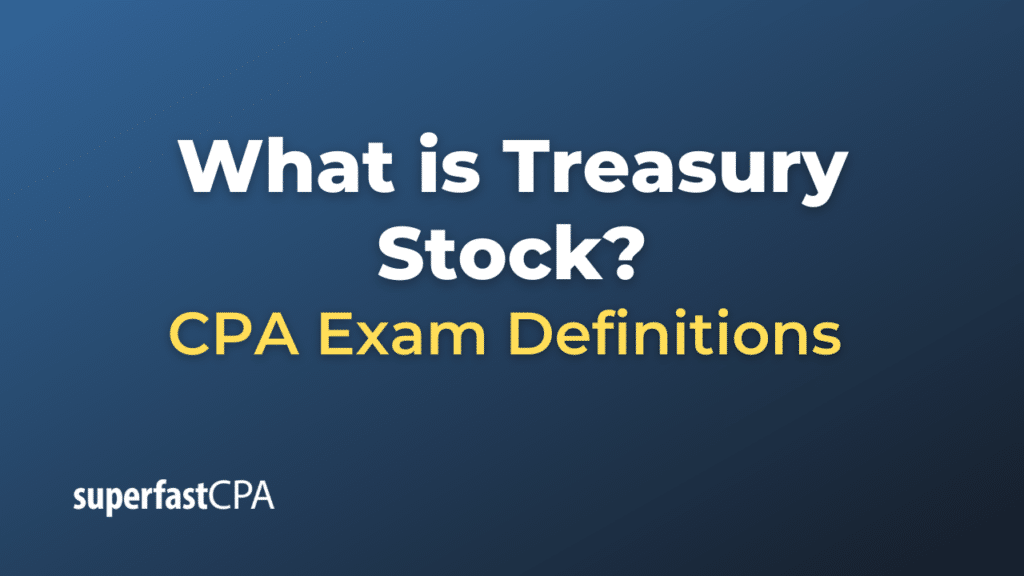Treasury Stock
Treasury stock, also known as treasury shares or buyback shares, refers to shares of a company’s own stock that have been reacquired by the company. When a company buys back its own shares from the open market or directly from its shareholders, those shares don’t simply vanish. Instead, they are held by the company in its own treasury and are known as treasury stock. These shares don’t pay dividends, have no voting rights, and are not included in the count of outstanding shares when earnings per share (EPS) or other per-share metrics are calculated.
There are several reasons why a company might decide to buy back its own shares:
- Increase Earnings Per Share (EPS): Reducing the number of shares outstanding can increase EPS, making the company appear more attractive to investors.
- Provide Stock for Employee Compensation Plans : Companies might use treasury stock to fulfill obligations under employee stock option plans, stock bonus plans, or other compensation arrangements.
- Capital Structure Management: A company might feel its stock is undervalued and buy it back as an investment. Additionally, repurchasing shares can alter the firm’s debt-to-equity ratio.
- Counteract Dilution : Share buybacks can help offset the dilution of earnings that occurs when options are exercised or when convertible securities are converted into stock.
- Support Stock Price : By indicating that the company believes its stock is undervalued, a buyback can signal confidence to the market and support the stock price. Additionally, the act of buying back shares can exert upward pressure on the stock price.
- Prevent Hostile Takeovers: By buying back its own shares, a company can reduce the number of shares available in the open market, potentially making it more difficult for another entity to acquire a controlling interest in the company.
On a company’s balance sheet, treasury stock is typically recorded as a contra equity account under shareholders’ equity. This means it has a credit balance instead of a debit balance and reduces total shareholders’ equity.
Example of Treasury Stock
Let’s consider a hypothetical example to illustrate the concept of treasury stock.
Scenario:
TechPulse Inc. is a publicly traded technology company. Over the years, the company issued a total of 1 million shares of stock, which are all currently in the hands of public shareholders. Due to its continued success, the company has accumulated a significant cash reserve.
After an analysis, TechPulse decides to buy back 50,000 of its own shares from the market at $20 per share.
Transaction Details:
- Shares Bought Back: 50,000
- Price per Share: $20
- Total Cost of Buyback: 50,000 shares x $20/share = $1,000,000
Effects of the Buyback:
- Treasury Stock : After the buyback, TechPulse will record $1,000,000 as treasury stock on its balance sheet, which will reduce its total shareholders’ equity by the same amount.
- Outstanding Shares: The number of shares outstanding will decrease from 1 million to 950,000 shares (1 million – 50,000). This could potentially increase the earnings per share (EPS), assuming the company’s net income remains unchanged.
- No Voting Rights or Dividends: The 50,000 shares held as treasury stock will not have voting rights and will not be entitled to dividends.
Future Scenarios:
- Resale of Treasury Stock: In the future, if TechPulse decides to resell 20,000 of its treasury shares for $25 per share, it would receive $500,000 in cash. Any difference between the sale price and the cost of the treasury stock (in this case, a gain of $5 per share or $100,000 for 20,000 shares) does not go to the income statement but is usually recorded in additional paid-in capital (a part of shareholders’ equity).
- Use for Employee Compensation : TechPulse could also decide to use some of the treasury shares for employee stock options or bonus plans.
This example provides an overview of how treasury stock transactions might appear for a company and the potential implications of such buybacks.













